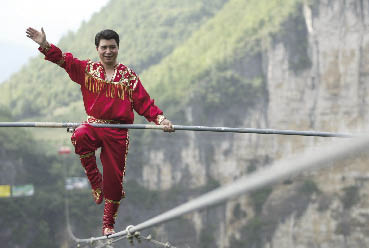|
King of the Tightrope
 |
|
Walk like a man: Ahdili is king of the tightrope and a world record holder for the longest, the highest, and the riskiest acts. Photos by China Foto Press |
Back to Ahdili – the most notable Darwaz performer. Born in 1971 in Yengisar County, Xinjiang, Ahdili is a sixth-generation Darwaz master. Darwaz dynasties are made by passing down the art from generation to generation. Ahdili's father, the Darwaz fifth-generation successor, spent a lifetime studying and performing Darwaz and didn't retire until he reached age 72. Oddly, he made a will that specified his children were not to engage in Darwaz performance because the occupation is just too risky. When Ahdili's father died at the age of 76, he was only five years old. By the time he had matured a little, the adventurous nature of Ahdili's heart made him rebel against his father's last wishes. He stepped onto the Darwaz rope at age ten, after convincing his late father's good friend to teach him the art.
Ahdili was a fast learner. Though young, he practiced so hard that his daily work out on the ropes were often as long as eight uninterrupted hours. Four years later, Ahdili did his first Darwaz show in celebration of the 30th anniversary of Xinjiang Uygur Autonomous Region. At that point he realized Darwaz was his life's work.
Twenty years into his life as a tightrope walker, Ahdili has set numerous records with his incredible courage and superb skills. He broke his first Guinness World Record in 1997 by crossing a 600-meter span of the Three Gorges on the Yangtze River in 13 minutes and 48 seconds. After that, Ahdili successively set records for the world's longest and highest crossing of a wire without safety provisions. He was justly hailed as the king of the tightrope.
Waiting in the Wings
Uygur people have always treasured Darwaz since it fully embodies human ambition, bravery and resourcefulness in the face of hardship.
In 2006, the Darwaz art was listed by the national government as an intangible cultural heritage. Governmental support provides the artists with better conditions to preserve and further develop this centuries-old art.
Many artists are now devoting themselves to taking on more apprentices to increase the chances of Darwaz's survival and continuation through subsequent generations. At the same time, more children are showing their interest and training in its skills. And parents believe that learning Darwaz gives children an opportunity to be courageous and confident.
In Ahdili's hometown, a Darwaz training center is under construction. It will likely attract both domestic and overseas learners, who are expected to spread this cultural heritage to the world. Apart from these pupils waiting in the wings, Ahdili is currently teaching his little daughter the high wire art.
Like Ahdili, all the Darwaz artists are showing much confidence in the young novices, their would-be successors. Those who carry it on can bring new vigor to this old art and one day the new generation will be going further and higher to break those records.
| 